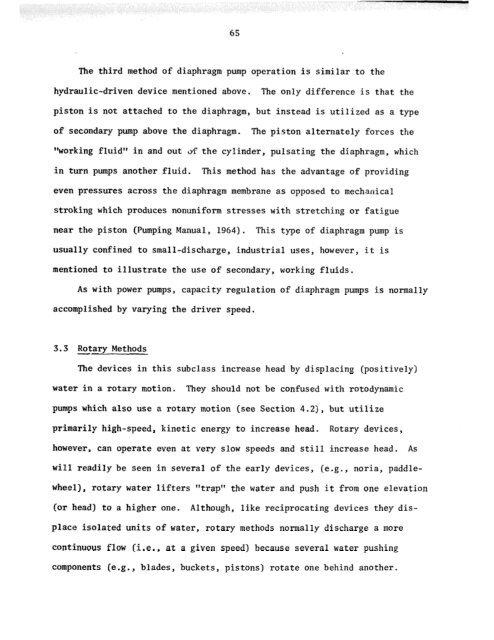- Page 1:
MICROFICHEREFERENCELIBFUUWA project
- Page 4 and 5:
TABLE OF CONTENTS:.LIST OF FIGURES
- Page 6 and 7:
LIST OF FIGURES (CONT)Figure3.163.1
- Page 8 and 9:
LIST OF TABLESTable2.12.2a2.2b3.13.
- Page 10 and 11:
2find both new water lifting device
- Page 12 and 13:
4During the 3rd centuryB.C., Archim
- Page 14 and 15:
GIn 1698, Thomas Savery obtained a
- Page 16 and 17:
9the United States was starting set
- Page 18 and 19:
11engines, motors, transmissions, e
- Page 20 and 21:
Chapter 2Water LiftingPrinciples2.1
- Page 22 and 23: 15Table 2.2a Classification of wate
- Page 24 and 25: 2.2.1 Discharge or Capacity (Q)Disc
- Page 26 and 27: (h) Drawdown (D) is the vertical di
- Page 28 and 29: 21Tota I DynamicHeadI Total Static
- Page 30 and 31: 23Vapor Pressure (P,)Suction Fricti
- Page 32 and 33: Multiplying all these efficiencies
- Page 34 and 35: 27NPSHR-Q, is also usually included
- Page 36 and 37: 3.2.1.1 Bucket/BagUtilizing nothing
- Page 38 and 39: handmade construction can be easily
- Page 40: animal is returning to the top, the
- Page 43 and 44: 363.2.1-S Counterpoise LiftThe coun
- Page 45 and 46: 38to return the lever. Combinations
- Page 47 and 48: 40Table 3.1Shadouf performanceLift
- Page 49 and 50: (b)Figure 3.5 Scoop (a) used as sho
- Page 51 and 52: ‘PIVOT-r- ----hFigure 3.6 Wzcer b
- Page 53 and 54: 46water. The capacity of this devic
- Page 55 and 56: - =7?=PIVOTCOUNTER WEIGHT\FLAP- VAL
- Page 57 and 58: 50(a)ROLLER 7- HAND RAIL/SIDE - BY-
- Page 59 and 60: 52flow in through a check-valve (e.
- Page 61 and 62: 54exhaust valves for the steam (or
- Page 63 and 64: 56Another significant difference be
- Page 65 and 66: 58shaft), two other forms of these
- Page 67 and 68: 60Among the simplest designs for a
- Page 69 and 70: 62/HANDLEBARDISCHARGEHOSEfFOOTRE$TD
- Page 71: HANDLE/CONNECTINGARMDISCHARGEFLAP V
- Page 75 and 76: 68Table 3.2 Manually-operated paddl
- Page 77 and 78: 70engine (2-3 hp) as the prime move
- Page 79 and 80: 72Table 3.3 records some of the per
- Page 81 and 82: 74Several names which are also appl
- Page 83 and 84: 76Table 3.5Zawafa performanceLiftDi
- Page 85 and 86: 78noria and the discharge and head
- Page 87 and 88: 80enclosed circumference can also b
- Page 89 and 90: 82Most early tympanums were of the
- Page 91 and 92: 84Table 3.6Tympanum performanceDiam
- Page 93 and 94: 86sufficiently compact and lightwei
- Page 95 and 96: 88of 3000 gpm or 5000 psig. Dependi
- Page 97 and 98: SE;vlI - ROTARYBUCKET VANEU’C)Fig
- Page 99 and 100: 92(a)AIRCHAMBERAIR FEEDERVALVEWASTE
- Page 101 and 102: 94Table 3.8Ram performanceA. Typica
- Page 103 and 104: COMPRESSEDAIRDEAofpctI5LT1EDUCTC II
- Page 105 and 106: 98FLASHTANK .iJI 10 -NON-RETURNVALV
- Page 107 and 108: Because the components are not yet
- Page 109 and 110: 102air-lift pumps. The oscillation
- Page 111 and 112: 104and from the impeller and confin
- Page 113 and 114: 106making this type pump useful for
- Page 115 and 116: 90s; 80iTi!g 700E 60W50SPECIFIC SPE
- Page 117 and 118: 110to lubricate all or some of thei
- Page 119 and 120: 112such variables as impeller size,
- Page 121 and 122: 114GEAR HEADOR IVE SHAFTTO PRIME MO
- Page 123 and 124:
116W(clFigure 4.6 (a) Thai-style ou
- Page 125 and 126:
118DRIVINGSUCTIONDIFFUSERa- - =tQ,E
- Page 127 and 128:
DISCHARGELINE OISCHARGE RETURNLINEL
- Page 129 and 130:
-122which at $.20/kg, cost $6.00. H
- Page 131 and 132:
Table 5.1Manual power appl icat i a
- Page 133 and 134:
126water lifting device. Animals ar
- Page 135 and 136:
1285.4.1 WindWindmills are currentl
- Page 137 and 138:
130even saw use on the windy plains
- Page 139 and 140:
172HAL F CYLINDERSt------TO WATER L
- Page 141 and 142:
135a vertical shaft, the wind will
- Page 143 and 144:
--Table 5.3 Typical winchnil 1 clpp
- Page 145 and 146:
Table 5.4 Typical watermill applica
- Page 147 and 148:
141MEDIUM BREASTFigure 5.6 (a) Medi
- Page 149 and 150:
SLUICEGATEc, ~/I#/,.----- ------I L
- Page 151 and 152:
145-H-f -- WH---@II
- Page 153 and 154:
147with a 330,250 gpd capacity. Bat
- Page 155 and 156:
149Where electric power is not econ
- Page 157 and 158:
151electricity), the amount of use
- Page 159 and 160:
153of building and installing the d
- Page 161 and 162:
155II 300‘0083ooLoo93oo‘ootr000
- Page 163 and 164:
157Example G .l (after Molenaar, 19
- Page 165 and 166:
LOW LIFT VERTICAL PUA /lPI------PER
- Page 167 and 168:
Chapter 7Improvements and Research
- Page 169 and 170:
163example for further projects (Fa
- Page 171 and 172:
165Reynolds (1970) writes, " . ..ma
- Page 173 and 174:
16?BIBLIOGKAPlIYAddison, Ii., Ccntr
- Page 175 and 176:
169Committee on Water Supply Engine
- Page 177 and 178:
Gatz, C. A., Johnston Vertical Pump
- Page 179 and 180:
173Mother Earth News,1574.Ilandbook
- Page 181 and 182:
175Reynolds, I. II. , “High Duty
- Page 183 and 184:
177Svcndsen, M., "Irrigation Techno
- Page 185 and 186:
179APPENDIX
- Page 187 and 188:
Tabic;: A.2 Area conversions and ab
- Page 189 and 190:
Table A.4 Pressure conversions and
- Page 191 and 192:
Table A.6 Discharge conversions and
- Page 193 and 194:
Table'A.8 Specific speed (N,) conve
- Page 195:
ABHPDD- area- brake horsepower- dia
















